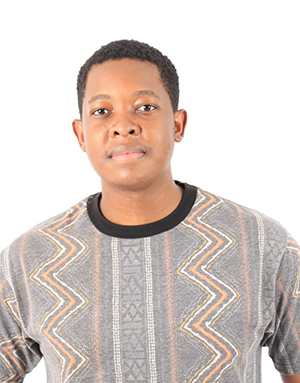News & Events
Masedi’s Unisa journey takes him to the University of Zagreb

Masedi Masekane
After completing his Master of Science in Physics qualification (cum laude, 2020) at Unisa, Masedi Masekane longed to carry out his PhD in a manner that would challenge him beyond the normal requirements of a generic doctoral programme.
This was inspired by his keen interest in ion-beam analysis techniques, which he first came across while an undergraduate student at the Tshwane University of Technology (TUT). Such was his love for this area of applied nuclear physics that he garnered a number of accolades during his MSc years. These include winning the French Vacuum Society’s Michel Cantarel Prize in 2019 for an oral presentation at the International Ion-Beam Analysis (IBA) conference in Antibes, France, and the 2018 South African Institute of Physics prize for the best MSc oral presentation in the division of nuclear, particle and radiation physics.
Prior to that, Masekane participated in the 2016 JINR-SA Student Practice programme in Dubna, Russia, during his honours year. It then became a personal goal of his to push the boundary a little further, with respect to what he personally regards as the “final stage'” of his formal study journey towards becoming a credible scientist in the field of physics.
Double credibility
Masekane then learned of the possibility of carrying out a PhD jointly supervised by two universities. He decided to contact his mentor and supervisor, Professor Mandla Msimanga (TUT/iThemba LABS) to discuss the feasibility of his proposal as well any recommended potential collaborators from established IBA laboratories in Europe.
Msimanga, working with Professor Sabata Moloi (Department of Physics, Unisa), secured the support of a research colleague, Dr Ivančica Bogdanović Radović, from the Ruder Boskovic Institute (RBI) of Croatia, to be Masedi’s official supervisor on the Croatian side. Radović became instrumental in guiding Masedi through the PhD application process into the biggest university in Croatia and one of the oldest in Europe, the University of Zagreb. To facilitate his studies in Croatia, the International Atomic Energy Agency (IAEA) recently awarded him a prestigious PhD Sandwich Fellowship spanning over one year, lasting for the remaining duration of his doctoral degree.
We sat down with Masedi to understand what his joint PhD degree entails, and this is what he had to say.
Please give us a brief background to your joint PhD degree – what it entails, your progress thus far, the universities involved, and the significance (advantages) of doing a joint PhD degree vs a generic one.
The PhD in Physics and Doctoral Study in Nuclear Physics is in essence a composite of two PhD programmes – one from the University of South Africa, and the other from the University of Zagreb (UniZG) in Croatia. I enrolled for both programmes separately, and had to go through the screening processes (i.e. proposals, proposal colloquium from Unisa; proposal and interview on the UniZG side) as would any student before initiating the Cotutelle (agreement for joining the two degrees) process between the two universities. The requirements of both programmes are retained, after which two PhD certificates will be awarded upon the completion of a single doctoral thesis submitted to both institutions. The two certificates shall, however, be considered as one PhD qualification, jointly awarded by the two universities.
My research project is carried out in close collaboration with the laboratory for Ion-Beam Interactions (LIBI) of the RBI in Zagreb, as well the Ion-Beam Analysis group at the iThemba Laboratory for Accelerator Based Sciences (LABS) here in South Africa. iThemba LABS is a national research facility run by the National Research Foundation (NRF). The PhD programme is structured as a composite of both a research project and course work in experimental nuclear physics facilitated by the University of Zagreb. The courses (modules) taken are aimed at exposing me to frontier theoretical physics to bolster the experimental side of my work. I have so far enrolled for three mandatory courses (which I have passed at the highest grade level), and three elective courses (practical based) which I will complete before the end of this year.
The advantages of my research work being carried out between the RBI and iThemba LABS include exploiting the relative strengths of each lab as well as validating experiments carried out between the two laboratories. This is particularly important for iThemba LABS since my work is aimed at developing a new analytical technique for materials research. The joint degree thus enhances this partnership and also enables better access to tools not available in Africa and provides international exposure and experience. With South Africa being the leading African participant in this tech-intensive field, the main aim of this undertaking is thus to benchmark our study to international standards, through strengthening active collaboration between South Africa and Croatia in ion-beam analysis – as part of a bigger mission to affirm South Africa’s position in the global IBA arena. On a personal level, my exposure to a big international lab like the RBI can only expand my horizons. This is just the beginning for me.
In layman’s terms, what is your research focused on?
Ion-beam analysis (IBA) characterises a group of powerful accelerator-based nuclear analytical techniques used for materials analysis. The world around us is made of physical materials, and sometimes to study functional properties of materials we need probes that can go down to the atomic level. Ordinary microscopes cannot do that. If, however, we direct beams of charged atoms onto a piece of material, we can infer the structure and chemical composition (among other things), of that material from the interactions that take place between the beam and the atoms of the material.
The application of IBA methods spans across several disciplines, such as nanotechnology, medicine, microelectronics and sensors, and environmental sciences, to mention a few. With aerosol studies as one select example, we are able to accurately determine atomic concentrations of harmful elements present in our atmosphere and possibly map out their geographical concentration. Another exotic application, demonstrated by the NASA group, has been the analysis of Martian rocks, soils and dust for various element species and water using an IBA probe fitted to a rover on Mars.
Coming to my project, the aim is to spearhead part of the expansion of ion-beam analysis capabilities at iThemba LABS through the development of a new system which should be able to increase both the sensitivity and the efficiency of analyses through the use of heavy ions (compared to the usual protons used). On the technical side, the project seeks to combine three techniques into one, an approach called total-ion-beam analysis (TIBA), to enable a more complete description of a material in one go. From the physics side of things, a model is needed to account for some of the ion-atom interactions which only take place when using heavy ion beams. A machine-learning approach is being adopted to facilitate the development of a model which would enable us to carry out reliable analyses of any sample material. Once completed, not only will the system be the first and the only one of its kind in Africa, but it will aid the global adoption of a TIBA approach in materials analysis.
What is your advice to learners or prospective students who are sceptical about pursuing a degree in the field of physics?
A degree in physics not only equips one with analytical skills fit for solving complex physical and practical questions, but ensures that one has an enabling analytical aptitude to migrate into many other fields, even outside the disciplines of natural sciences. With an advanced qualification, such as a master’s degree in physics, one is afforded the ability to extend their career to many other areas in, for example, medicine, commerce and even engineering, making it quite a non-limiting career choice. Moreover, in South Africa, at a time where competition for limited employment opportunities is rife, flexibility within any career is always to one’s advantage. This, I think for any aspiring or junior student, ought to make the pursuit of physics appealing. It is for this reason, beyond the general philosophy of why we pursue science, that I would actively encourage anyone to formerly undertake physics as their study of choice.
*By Dr Nozipho N Gumbi, Acting Communication and Marketing Specialist, College of Science, Engineering and Technology and Lesego Maloka, Administrative Assistant, College of Science, Engineering and Technology
Publish date: 2022-04-07 00:00:00.0

